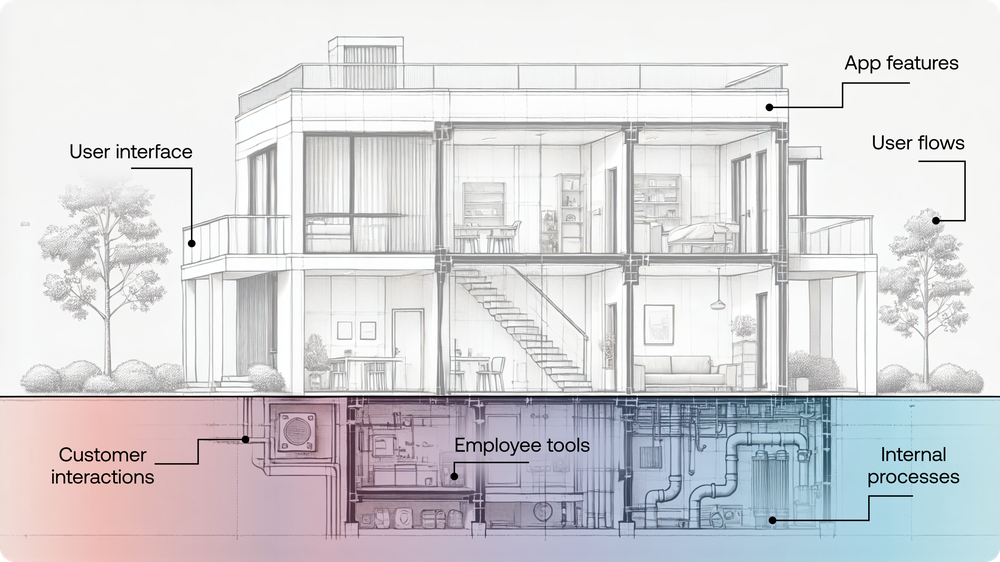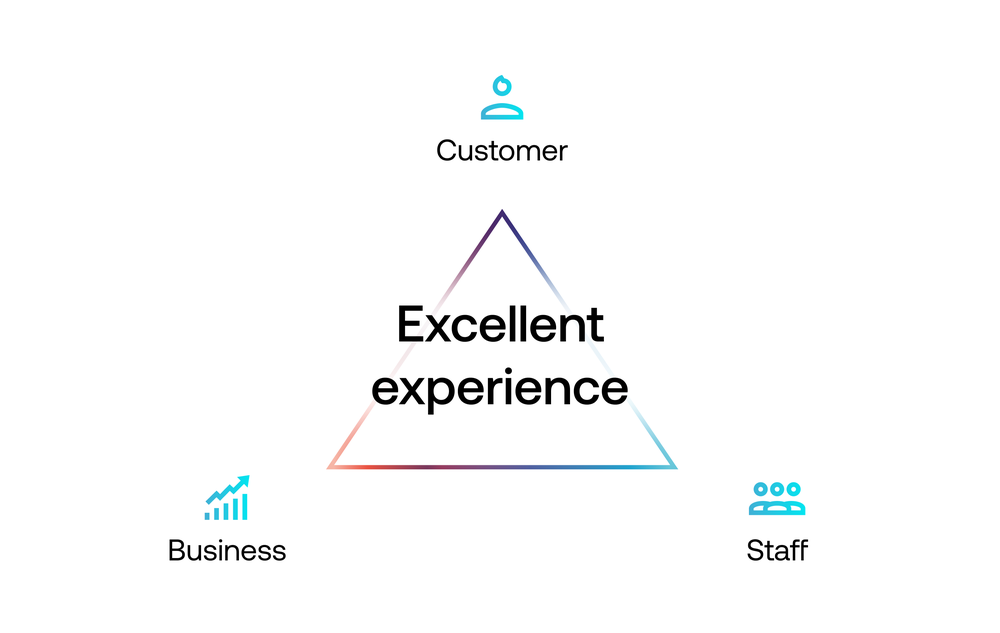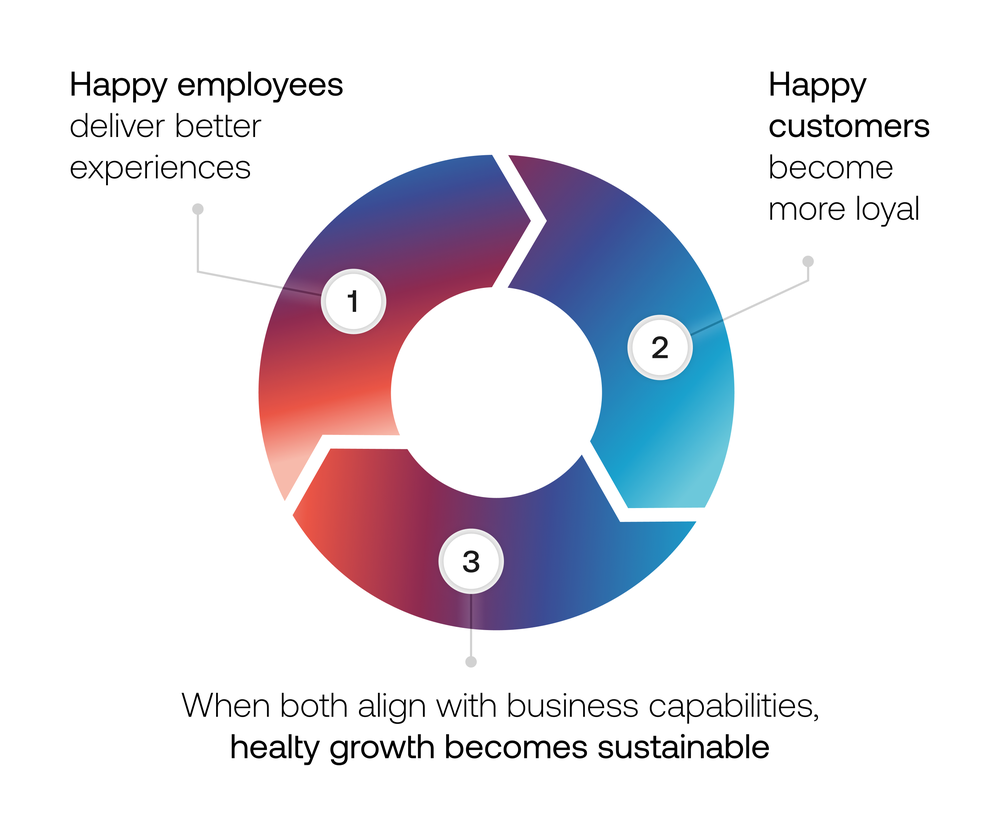
Clients often ask us how a mobile app can impact their business. The truth is, while a well-designed app can create real value, it’s not a silver bullet. It won’t solve every challenge on its own.
After working on dozens of projects, we’ve seen a clear pattern: great UX, strong features, and a shiny new app are just the tip of the iceberg. To truly improve customer experience, you need to look deeper – not just at your users and their expectations, but at the entire business. What happens inside affects what they feel as well.
When internal tools don’t work, employees get frustrated – and that frustration reaches customers. The result? Bad experiences, poor reviews, lost loyalty. So, how do you zoom out and make the right decisions?
This is where service design comes in – the missing link that ensures your customer experience is much more than just an app.
Service designers are like UX designers with x-ray vision. While UI and UX focus on what users see and click, service design examines the entire ecosystem – the internal processes, tools, and human interactions that power purchases.
Think of it like architecture:

A beautiful, say, banking app means nothing if:
Customers judge you by the entire structure, not just the front door, and service design ensures everything works together seamlessly.
A flawless app is worthless if the service behind it is broken.
A hotel can have the slickest booking app in the world, but if the front desk is understaffed, the room isn’t ready at check-in, and housekeeping keeps missing requests, the whole experience falls apart.
The consequences ripple across the entire organization. Customers face frustration when digital promises don't match reality – like when a seamless checkout leads to a stone-age return process. Employees struggle with tools that look modern but don't integrate with critical systems, creating unnecessary workarounds.
Meanwhile, the business bleeds value through invisible inefficiencies – disjointed processes that drive up operational costs while driving away customers.
Service design moves beyond surface-level fixes to fundamentally reshape how organizations deliver value. While individual touchpoints matter, the real magic happens when all these elements work in concert.
At its core, service design ensures that every promise made to customers is backed by an operational reality. It bridges the gap between what users expect and what the business can consistently deliver. This alignment transforms fragmented interactions into seamless experiences that build trust and loyalty over time.

The approach requires looking at three critical dimensions simultaneously:
This triad creates a virtuous cycle: When employees have what they need to succeed, they deliver better experiences. When customers feel understood, they become more loyal. When both align with business capabilities, the result is sustainable growth rather than unsustainable promises.

Great experiences don’t happen by accident. They happen by design, and that means looking beyond the screen.
Service design transforms good intentions into exceptional experiences by building on five core principles:

1. User-centered approach instead of guesswork
True understanding emerges when we study both customers' unarticulated pain points and employees' daily friction points. It's about recognizing that a beautifully designed app means little if frontline staff lack the tools or authority to resolve the issues it creates.
D-Marin’s overhaul showcases how great service design bridges digital innovation with real-world operations:
The key insight? True transformation happens when you design beyond the app screen – considering how every upgrade impacts employees’ workflows and customers’ actual behaviors. By mapping the complete service ecosystem – from sensor-equipped pylons to backoffice algorithms – D-Marin didn’t just digitalize processes, but created a new standard for marina experiences worldwide.
2. Co-creation, where perspectives collide
Service design thrives on inclusive collaboration – bringing together customers, frontline employees, and decision-makers in structured dialogues. These cross-functional sessions surface unspoken needs and operational constraints that traditional research often misses, leading to solutions that work for all stakeholders.
3. Holistic thinking beyond silos
True service excellence requires seeing beyond isolated touchpoints – it demands mapping how all components interconnect. This means examining every channel (digital and physical), each process (visible and backstage), all roles (customers to employees), and the technologies that bind them.
4. Iterative progress – learn before you launch
Service design uses iterative cycles, like phased rollouts or feature flagging, to test, adapt, and refine solutions at every stage. By treating services as works-in-progress, organizations uncover friction early, align with user needs, and reduce implementation risks. This continuous improvement ensures services evolve as seamlessly as the needs they address.
5. Visualizing the invisible
Service blueprints turn process maps into strategic tools, visually exposing friction across the customer journey. By aligning touchpoints with backstage operations, they pinpoint breakdowns between departments or systems, helping organizations prioritize high-impact fixes.
These five principles work together to create services that are both human-centered and operationally sound.
Service design is the strategic lens that aligns user needs, business goals, and operational capabilities into one seamless system. In an era of rising customer expectations and shrinking loyalty, the winners will be brands that deliver consistent, end-to-end excellence – where every interaction, from digital touchpoints to human support, feels intentional and effortless.
This is just the beginning. In our next article of the series, we’ll explore how B2C expertise elevates B2B and B2E experiences – and why consumer-grade intuitiveness should be the standard, no matter the industry.
Because in the end, great experiences aren’t B2B or B2C – they’re simply human.